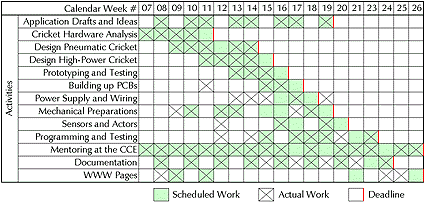![[Jump to Cover]](cover.gif) |
![[Jump to Contents]](contents.gif) |
![[Jump to Introduction]](introduc.gif) |
 |
![[Jump to Realization]](realiza.gif) |
![[Jump to Conclusion]](conclusi.gif) |
![[Jump to Appendix]](appendix.gif) |
2 Concepts
2.1 Project Schedule
The project schedule was actually set up after the objectives of the diploma thesis and the technical requirements had been defined (see sections 2.2 and 2.3). However, the chronological sequence in this documentation has been reordered in order to achieve a better clarity, and to help keeping track of the sequence of tasks as well as their interdependencies. The individual tasks are described very briefly here, as a detailed explanation will be given in the Realization section (see 3).At the end of each task, a deadline marker indicates the scheduled completion of that stage. As some activities (e.g., "programming and testing") depended on the previous ones to be finished, it has been important to keep to the scheduled order. After each week’s work, the tasks that had actually been worked on have been entered into the table.
Some minor rescheduling was done for the last few weeks because the deadline for the documentation to be completed was set to calendar week #24. Besides, calendar week #22 was taken out of the schedule due to a study trip during that week.

Also included is the design of further options that may be prepared for future implementation. A central aspect of "mentoring at the CCE" is to check out planned applications together with the kids and see whether they are practicable.
"Cricket hardware analysis" is preliminary work in order to understand the Cricket design and the potential it provides for hardware extensions. During the project, it became clear that also profound knowledge of the various software tools used to program the Crickets is necessary, as they differ widely in their respective functionality. On the project schedule however, software testing is included in "programming and testing", which explains why more time was needed there.
The two Cricket add-ons, "Pneumatic Cricket" and "High Power Cricket" could actually be completed at the same time – one week earlier than expected. The reasons were that some of the electronic devices are the same in both circuits, and that parts of the layout could be adapted. This accelerated the stages "design", "prototyping and testing", as well as "building up PCBs" (printed circuit boards).
"Power supply and wiring" on the other hand was extended by one week. This was due to additional ideas on how to improve the Crickets’ flexibility in use: First, several power supply adapters (voltage regulator modules) were designed and built up, which can replace batteries in environments where stationary power supply is available. Then, a rechargeable battery block was added, which has ten times the capacity of a standard battery. These are also significant improvements with respect to environmental protection.
"Mechanical preparations" and the design of additional "sensors and actors" took less time than expected. However, for each additional mechanical or electronic device (e.g., sensor, motor, pneumatic valve, etc.), some more work on the mechanical and/or electrical interfaces will need to be done. Examples and suggestions for this can be found in the sections 3.5 and 3.6.
The "documentation" work has been done as a parallel process during the project. Any significant step was noted, intermediate drafts and file versions saved for backup as well as documentary purposes.
Some of the "WWW pages" were created in the beginning, the major part at the end of the project: The first pages introduced the intended thesis work to mentors and kids at the CCE, while the final WWW documentation includes the complete diploma thesis in both HTML and PDF formats.
Finally, the whole project could be completed successfully within the given time.